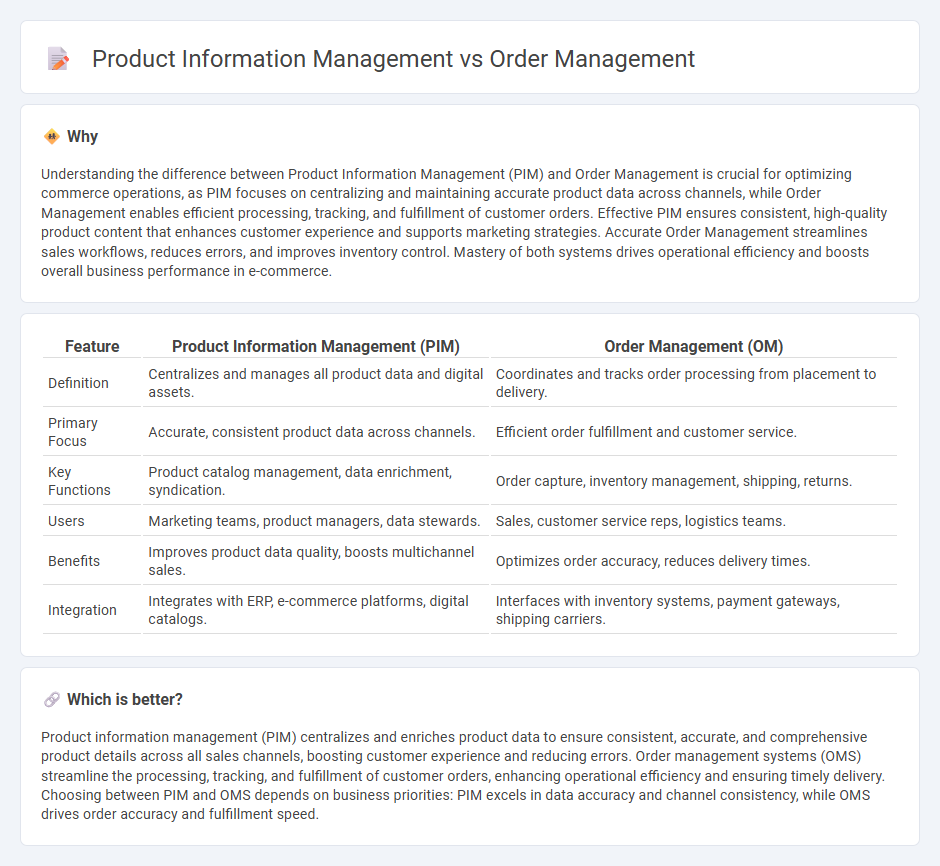
Product information management (PIM) centralizes and organizes detailed product data to ensure accuracy across multiple sales channels, enhancing customer experience and inventory control. Order management systems (OMS) handle the entire order lifecycle, from order capture to fulfillment and delivery, optimizing operational efficiency and customer satisfaction. Explore how integrating PIM and OMS solutions can streamline commerce operations and boost revenue.
Why it is important
Understanding the difference between Product Information Management (PIM) and Order Management is crucial for optimizing commerce operations, as PIM focuses on centralizing and maintaining accurate product data across channels, while Order Management enables efficient processing, tracking, and fulfillment of customer orders. Effective PIM ensures consistent, high-quality product content that enhances customer experience and supports marketing strategies. Accurate Order Management streamlines sales workflows, reduces errors, and improves inventory control. Mastery of both systems drives operational efficiency and boosts overall business performance in e-commerce.
Comparison Table
| Feature | Product Information Management (PIM) | Order Management (OM) |
|---|---|---|
| Definition | Centralizes and manages all product data and digital assets. | Coordinates and tracks order processing from placement to delivery. |
| Primary Focus | Accurate, consistent product data across channels. | Efficient order fulfillment and customer service. |
| Key Functions | Product catalog management, data enrichment, syndication. | Order capture, inventory management, shipping, returns. |
| Users | Marketing teams, product managers, data stewards. | Sales, customer service reps, logistics teams. |
| Benefits | Improves product data quality, boosts multichannel sales. | Optimizes order accuracy, reduces delivery times. |
| Integration | Integrates with ERP, e-commerce platforms, digital catalogs. | Interfaces with inventory systems, payment gateways, shipping carriers. |
Which is better?
Product information management (PIM) centralizes and enriches product data to ensure consistent, accurate, and comprehensive product details across all sales channels, boosting customer experience and reducing errors. Order management systems (OMS) streamline the processing, tracking, and fulfillment of customer orders, enhancing operational efficiency and ensuring timely delivery. Choosing between PIM and OMS depends on business priorities: PIM excels in data accuracy and channel consistency, while OMS drives order accuracy and fulfillment speed.
Connection
Product Information Management (PIM) centralizes accurate product data, ensuring consistency across sales channels, which directly supports efficient Order Management systems by providing reliable item details for order processing. Seamless integration between PIM and Order Management enables real-time inventory updates, reduces errors in order fulfillment, and enhances customer satisfaction through accurate product availability information. Synchronizing these systems streamlines supply chain operations and improves overall commerce performance by aligning product data with order workflows.
Key Terms
Order management:
Order management centralizes the coordination of sales, inventory, and fulfillment processes to ensure accurate order processing and timely delivery, enhancing customer satisfaction and operational efficiency. It integrates seamlessly with inventory management systems, payment gateways, and shipping providers to provide real-time updates and streamline order lifecycle management. Discover more about optimizing order workflows and improving business performance through advanced order management solutions.
Order Processing
Order management centers on the efficient handling of customer orders, including order entry, tracking, fulfillment, and invoicing to ensure accurate and timely delivery. Product information management (PIM) maintains and organizes product data, such as descriptions, specifications, and pricing, essential for supporting order accuracy but does not directly process orders. Explore more to understand how integrating order management systems with PIM improves overall order processing efficiency.
Fulfillment
Order management streamlines the end-to-end fulfillment process by tracking order status, inventory levels, and delivery schedules to ensure timely shipment and customer satisfaction. Product information management centralizes accurate product data, including descriptions, specifications, and pricing, which supports efficient order processing and reduces errors in fulfillment. Explore how integrating order management systems with product information management enhances operational efficiency and customer experience.
Source and External Links
What is Order Management? | DealHub - Order management is the process of tracking and managing customer orders from placement through fulfillment, aimed at accurate and timely delivery while minimizing costs through tools like OMS software and automation.
What is Order Management? | IBM - Order management tracks orders from inception to fulfillment, managing related people, processes, and data, often via OMS software to automate tasks, reduce errors, monitor inventory, and improve customer experience.
What Is Order Management? | Indeed.com - Order management is the end-to-end process of receiving, fulfilling, tracking customer orders, and handling after-sales services, helping businesses forecast demand, minimize errors, and enhance customer experience.
 dowidth.com
dowidth.com